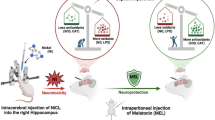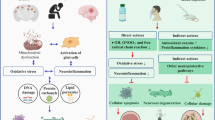Abstract
Methamphetamine (METH) known as a highly neurotoxic compound associated with irreversible brain cell damage that results in neurological and psychiatric abnormalities. The mechanisms of METH intoxication mainly involve intraneuronal events including oxidative stress, excitotoxicity, and dopamine oxidation. Based on recent studies, H2S can protect neurons through anti-inflammatory, antioxidant, and antiapoptotic mechanisms. Therefore, we aimed to study the effects of protection of H2S against METH neurotoxicity. The 72 male Wistar rats were randomly allocated into six groups: control (n, 12), H2S (n, 12), METH (n, 12), METH + H2S 1 mg/kg (n, 12), METH + H2S 5 mg/kg (n, 12), and METH + H2S 10 mg/kg (n, 12) groups, (NaHS as a H2S donor; 1, 5, 10 mg/kg). METH neurotoxicity was induced by 40 mg/kg of METH in four intraperitoneal (IP) injections (e.g., 4 × 10 mg/kg q. 2 h, IP). NaHS was administered at 30 min, 24 h, and 48 h after the final injection of METH. Seven days after METH injection, the brains were removed for biochemical assessments, glial fibrillary acidic protein (GFAP), and caspase-3 immunohistochemistry staining. H2S treatment could significantly increase both superoxide dismutase and glutathione (P < 0.01), and a reduction was observed in malondialdehyde (P < 0.05) and TNF-α (P < 0.01) versus the METH group. Moreover, H2S could significantly decrease caspase-3 and GFAP-positive cells in the CA1 region of the hippocampus (P < 0.01) compared to the METH group. According to the findings, H2S makes significant neuroprotective impacts on METH neurotoxicity due to its antioxidant and anti-inflammatory activities.






Similar content being viewed by others
References
Abe K, Kimura H (1996) The possible role of hydrogen sulfide as an endogenous neuromodulator. J Neurosci 16:1066–1071
Aboutaleb N, Shamsaei N, Khaksari M, Erfani S, Rajabi H, Nikbakht F (2015) Pre-ischemic exercise reduces apoptosis in hippocampal CA3 cells after cerebral ischemia by modulation of the Bax/Bcl-2 proteins ratio and prevention of caspase-3 activation. J Physiol Sci 65:435–443
Aboutaleb N, Shamsaei N, Rajabi H, Khaksari M, Erfani S, Nikbakht F, Motamedi P, Shahbazi A (2016) Protection of hippocampal CA1 neurons against ischemia/reperfusion injury by exercise preconditioning via modulation of Bax/Bcl-2 ratio and prevention of caspase-3 activation. Basic and clinical neuroscience 7:21
Alshehri FS, Althobaiti YS, Sari Y (2017) Effects of administered ethanol and methamphetamine on glial glutamate transporters in rat striatum and hippocampus. J Mol Neurosci 61:343–350
Asanuma M, Tsuji T, Miyazaki I, Miyoshi K, Ogawa N (2003) Methamphetamine-induced neurotoxicity in mouse brain is attenuated by ketoprofen, a non-steroidal anti-inflammatory drug. Neurosci Lett 352:13–16
Berman SB, Zigmond MJ, Hastings TG (1996) Modification of dopamine transporter function: effect of reactive oxygen species and dopamine. J Neurochem 67:593–600
Bowyer JF, Clausing P, Gough B, Slikker W Jr, Holson RR (1995) Nitric oxide regulation of methamphetamine-induced dopamine release in caudate/putamen. Brain Res 699:62–70
Cadet JL, Jayanthi S, Deng X (2003) Speed kills: cellular and molecular bases of methamphetamine-induced nerve terminal degeneration and neuronal apoptosis. FASEB J 17:1775–1788
Cadet JL, Krasnova IN, Jayanthi S, Lyles J (2007) Neurotoxicity of substituted amphetamines: molecular and cellular mechanisms. Neurotox Res 11:183–202
Casamenti F, Prosperi C, Scali C, Giovannelli L, Colivicchi M, Faussone-Pellegrini M, Pepeu G (1999) Interleukin-1β activates forebrain glial cells and increases nitric oxide production and cortical glutamate and GABA release in vivo: implications for Alzheimer’s disease. Neuroscience 91:831–842
Chen W-L, Niu Y-Y, Jiang W-Z, Tang H-L, Zhang C, Xia Q-M, Tang X-Q (2015) Neuroprotective effects of hydrogen sulfide and the underlying signaling pathways. Rev Neurosci 26:129–142
Cubells JF, Rayport S, Rajendran G, Sulzer D (1994) Methamphetamine neurotoxicity involves vacuolation of endocytic organelles and dopamine-dependent intracellular oxidative stress. J Neurosci 14:2260–2271
Davidson C, Gow AJ, Lee TH, Ellinwood EH (2001) Methamphetamine neurotoxicity: necrotic and apoptotic mechanisms and relevance to human abuse and treatment. Brain Res Rev 36:1–22
Erfani S, Aboutaleb N, Oryan S, Shamsaei N, Khaksari M, Kalalian-Moghaddam H, Nikbakht F (2015a) Visfatin inhibits apoptosis and necrosis of hippocampus CA3 cells following transient global ischemia/reperfusion in rats. Int J Pept Res Ther 21:223–228
Erfani S, Khaksari M, Oryan S, Shamsaei N, Aboutaleb N, Nikbakht F (2015b) Nampt/PBEF/visfatin exerts neuroprotective effects against ischemia/reperfusion injury via modulation of Bax/Bcl-2 ratio and prevention of caspase-3 activation. J Mol Neurosci 56:237–243
Erfani S, Moghimi A, Aboutaleb N, Khaksari M (2018) Nesfatin-1 improve spatial memory impairment following transient global cerebral ischemia/reperfusion via inhibiting microglial and caspase-3 activation. J Mol Neurosci 65:377–384
Gelbard HA, Dzenko KA, Diloreto D, Del Cerro C, Del Cerro M, Epstein LG (1993) Neurotoxic effects of tumor necrosis factor alpha in primary human neuronal cultures are mediated by activation of the glutamate AMPA receptor subtype: implications for AIDS neuropathogenesis. Dev Neurosci 15:417–422
Gheibi S, Aboutaleb N, Khaksari M, Kalalian-Moghaddam H, Vakili A, Asadi Y, Mehrjerdi FZ, Gheibi A (2014) Hydrogen sulfide protects the brain against ischemic reperfusion injury in a transient model of focal cerebral ischemia. J Mol Neurosci 54:264–270
Gonçalves J, Martins T, Ferreira R, Milhazes N, Borges F, Ribeiro CF, Malva JO, Macedo TR, Silva AP (2008) Methamphetamine-induced early increase of IL-6 and TNF-α mRNA expression in the mouse brain. Annals of the New York Academy of Sciences 1139:103–111
Gonçalves J, Baptista S, Martins T, Milhazes N, Borges F, Ribeiro CF, Malva JO, Silva AP (2010) Methamphetamine-induced neuroinflammation and neuronal dysfunction in the mice hippocampus: preventive effect of indomethacin. Eur J Neurosci 31:315–326
Hers H (1963) α-Glucosidase deficiency in generalized glycogen-storage disease (Pompe’s disease). Biochem J 86:11–16
Hu LF, Wong PTH, Moore PK, & Bian JS (2007). Hydrogen sulfide attenuates lipopolysaccharideinduced inflammation by inhibition of p38 mitogen‐activated protein kinase in microglia. Journal of neurochemistry, 100(4):1121–1128
Jayanthi S, Ladenheim B, Andrews A, Cadet J (1999) Overexpression of human copper/zinc superoxide dismutase in transgenic mice attenuates oxidative stress caused by methylenedioxymethamphetamine (ecstasy). Neuroscience 91:1379–1387
Kadiiska MB, Gladen B, Baird D, Graham L, Parker C, Ames B, Basu S, Fitzgerald G, Lawson J, Marnett L (2005) Biomarkers of oxidative stress study: III. Effects of the nonsteroidal anti-inflammatory agents indomethacin and meclofenamic acid on measurements of oxidative products of lipids in CCl4 poisoning. Free Radic Biol Med 38:711–718
Kato H, Araki T, Imai Y, Takahashi A, Itoyama Y (2003) Protection of dopaminergic neurons with a novel astrocyte modulating agent (R)-(−)-2-propyloctanoic acid (ONO-2506) in an MPTP-mouse model of Parkinson’s disease. J Neurol Sci 208:9–15
Kimura H (2012) Hydrogen sulfide: production, release, and functions. Nihon yakurigaku zasshi Folia pharmacologica Japonica 139:6–8
Lee YW, Son KW, Flora G, Hennig B, Nath A, Toborek M (2002) Methamphetamine activates DNA binding of specific redox-responsive transcription factors in mouse brain. J Neurosci Res 70:82–89
Li L, Mohamed MSB, Moore PK (2013) Multiple roles of H 2 S in inflammation: a new class of therapeutics? Hydrogen Sulfide and its Therapeutic Applications. Springer, Vienna, p 63–82
Marshall JF, O’Dell SJ (2012) Methamphetamine influences on brain and behavior: unsafe at any speed? Trends Neurosci 35:536–545
Mehrjerdi FZ, Aboutaleb N, Pazoki-Toroudi H, Soleimani M, Ajami M, Khaksari M, Safari F, Habibey R (2015) The protective effect of remote renal preconditioning against hippocampal ischemia reperfusion injury: role of KATP channels. J Mol Neurosci 57:554–560
Michiels C, Raes M, Toussaint O, Remacle J (1994) Importance of Se-glutathione peroxidase, catalase, and Cu/Zn-SOD for cell survival against oxidative stress. Free Radic Biol Med 17:235–248
Miljković D, Timotijević G, & Stojković MM. (2011). Astrocytes in the tempest of multiple sclerosis. FEBS letters, 585(23):3781–3788
Morgan JE (2000) Optic nerve head structure in glaucoma: astrocytes as mediators of axonal damage. Eye 14:437–444
Northrup NA, Yamamoto BK (2011) Neuroimmune pharmacology from a neuroscience perspective. J NeuroImmune Pharmacol 6:10–19
O’Dell SJ, Weihmuller FB, Marshall JF (1991) Multiple methamphetamine injections induce marked increases in extracellular striatal dopamine which correlate with subsequent neurotoxicity. Brain Res 564:256–260
Pereira FC, Lourenço E, Milhazes N, Morgadinho T, Ribeiro CF, Ali SF, Macedo TR (2006) Methamphetamine, morphine, and their combination. Annals of the New York Academy of Sciences 1074:160–173
Qin L, Liu Y, Cooper C, Liu B, Wilson B, & Hong JS (2002). Microglia enhance β‐amyloid peptideinduced toxicity in cortical and mesencephalic neurons by producing reactive oxygen species. Journal of neurochemistry, 83(4):973–983.
Robbins DS, Shirazi Y, Drysdale B, Lieberman A, Shin H, Shin M (1987) Production of cytotoxic factor for oligodendrocytes by stimulated astrocytes. J Immunol 139:2593–2597
Seiden LS, Sabol KE (1996) Methamphetamine and methylenedioxymethamphetamine neurotoxicity: possible mechanisms of cell destruction. NIDA Res Monogr 163:1276
Stephans SE, Yamamoto BK (1994) Methamphetamine-induced neurotoxicity: roles for glutamate and dopamine efflux. Synapse 17:203–209
Szabó C (2007) Hydrogen sulphide and its therapeutic potential. Nat Rev Drug Discov 6:917–935
Tang X-Q, Shen X-T, Huang Y-E, Ren Y-K, Chen R-Q, Hu B, He J-Q, Yin W-L, Xu J-H, Jiang Z-S (2010) Hydrogen sulfide antagonizes homocysteine-induced neurotoxicity in PC12 cells. Neurosci Res 68:241–249
Thomas DM, Walker PD, Benjamins JA, Geddes TJ, Kuhn DM (2004) Methamphetamine neurotoxicity in dopamine nerve endings of the striatum is associated with microglial activation. J Pharmacol Exp Ther 311:1–7
Tomozawa Y, Yabuuchi K, Inoue T, Satoh M (1995) Participation of cAMP and cAMP-dependent protein kinase in β-adrenoceptor-mediated interleukin-1β mRNA induction in cultured microglia. Neurosci Res 22:399–409
Tyagi N, Moshal KS, Sen U, Vacek TP, Kumar M, Hughes WM Jr, Kundu S, Tyagi SC (2009) H2S protects against methionine–induced oxidative stress in brain endothelial cells. Antioxid Redox Signal 11:25–33
Westmoreland SV, Kolson D, Gonzalez-Scarano F (1996) Toxicity of TNFα and platelet activating factor for human NT2N neurons: a tissue culture model for human immunodeficiency virus dementia. J Neurovirol 2:118–126
Wrona MZ, Yang Z, Zhang F, Dryhurst G (1997) Potential new insights into the molecular mechanisms of methamphetamine-induced neurodegeneration. NIDA Res Monogr 173:146–174
Xuan A, Long D, Li J, Ji W, Zhang M, Hong L, Liu J (2012) Hydrogen sulfide attenuates spatial memory impairment and hippocampal neuroinflammation in beta-amyloid rat model of Alzheimer’s disease. J Neuroinflammation 9:202
Yang G, Wu L, Jiang B, Yang W, Qi J, Cao K, Meng Q, Mustafa AK, Mu W, Zhang S (2008) H2S as a physiologic vasorelaxant: hypertension in mice with deletion of cystathionine γ-lyase. Science 322:587–590
Yu S, Zhu L, Shen Q, Bai X, Di X (2015) Recent advances in methamphetamine neurotoxicity mechanisms and its molecular pathophysiology. Behav Neurol 2015:1–11
Zhang L-M, Jiang C-X, Liu D-W (2009) Hydrogen sulfide attenuates neuronal injury induced by vascular dementia via inhibiting apoptosis in rats. Neurochem Res 34:1984–1992
Zhao J, O’Connor T, Vassar R (2011) The contribution of activated astrocytes to Aβ production: implications for Alzheimer’s disease pathogenesis. J Neuroinflammation 8:150
Zou JY, Crews FT (2005) TNFα potentiates glutamate neurotoxicity by inhibiting glutamate uptake in organotypic brain slice cultures: neuroprotection by NFκB inhibition. Brain Res 1034:11–24
Acknowledgements
The authors are very thankful to Pirasteh Norozi, Mahnaz Mesripour Alavije, and Mohammad Taghi Rahimi for their kind and helpful collaborations.
Author information
Authors and Affiliations
Corresponding author
Ethics declarations
Ethical Approval
All applicable international, national, and/or institutional guidelines for the care and use of animals were followed.
Conflict of Interest
The authors declare that they have no conflict of interest.
Rights and permissions
About this article
Cite this article
Ghanbari, F., Khaksari, M., Vaezi, G. et al. Hydrogen Sulfide Protects Hippocampal Neurons Against Methamphetamine Neurotoxicity Via Inhibition of Apoptosis and Neuroinflammation. J Mol Neurosci 67, 133–141 (2019). https://doi.org/10.1007/s12031-018-1218-8
Received:
Accepted:
Published:
Issue Date:
DOI: https://doi.org/10.1007/s12031-018-1218-8




